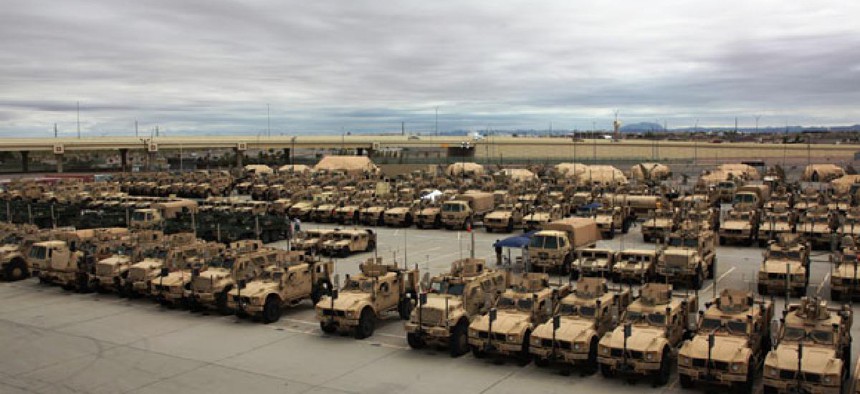Army equips 375 vehicles with radios for network tests

More than 360 vehicles sit at the Integration Motor Pool (IMP), located at Fort Bliss, Texas. Defense Department
Service runs assembly line to prep for evaluation.
As the Army prepares for its latest Network Integration Evaluation exercise this month at White Sands Missile Range, N.M., at nearby Fort Bliss, Texas, Col. Gail Washington ran what she described as a “Ford or GM assembly line” to equip 375 vehicles with network and radio gear.
Workers stuffed NIE test vehicles, including mine-resistant ambush-protected vehicle, Strykers and Humvees, with 1,800 separate systems, said Washington, project manager for the Army’s Systems of Systems Integration Directorate. She previously served at the Pentagon, where she ran a classified network for the Joint Chiefs of Staff.
Washington, who started her career in the enlisted ranks and went on to earn her commission along with computer and marketing degrees, said it’s her marketing degree that most prepared her for the job at Fort Bliss and with NIE. Good communication, she said, is essential for managing a mixed military and contractor team that includes personnel from the Space and Naval Warfare System Center in Charleston, S.C. The team already has installed network gear in MRAPs slated for delivery to the 10th Mountain Division, which is scheduled to deploy to Afghanistan in 2013.
Her job at Fort Bliss is to take engineering schematics and turn them into reality, a task that includes ensuring the NIE gear, which includes Joint Tactical Radio System radios undergoing a formal evaluation process along with 20 commercial systems, works. Tests must show that the systems have the right IP address on the tactical network and can transmit position and location information.
During the NIE exercise, which will be conducted in October and November by 3,800 soldiers of the 1st Armored Division’s 2nd Heavy Brigade Combat Team, Washington will help monitor the test, track problems and take care of her team of 600 military and contractor personnel, she said.
The radios and network equipment the Army will put through its paces at White Sands are the service’s top modernization priority. Washington’s priority, she said, was making sure her troops stay sufficiently hydrated to withstand the hot, dry climate at White Sands.



